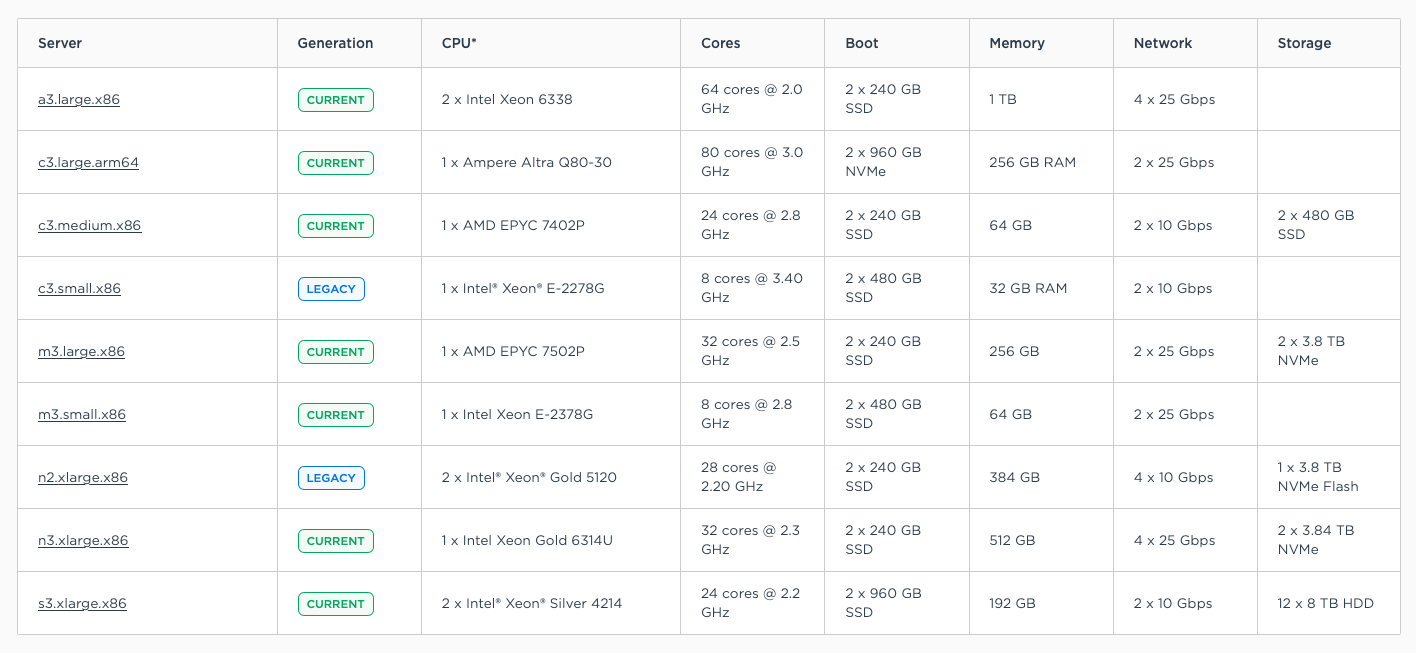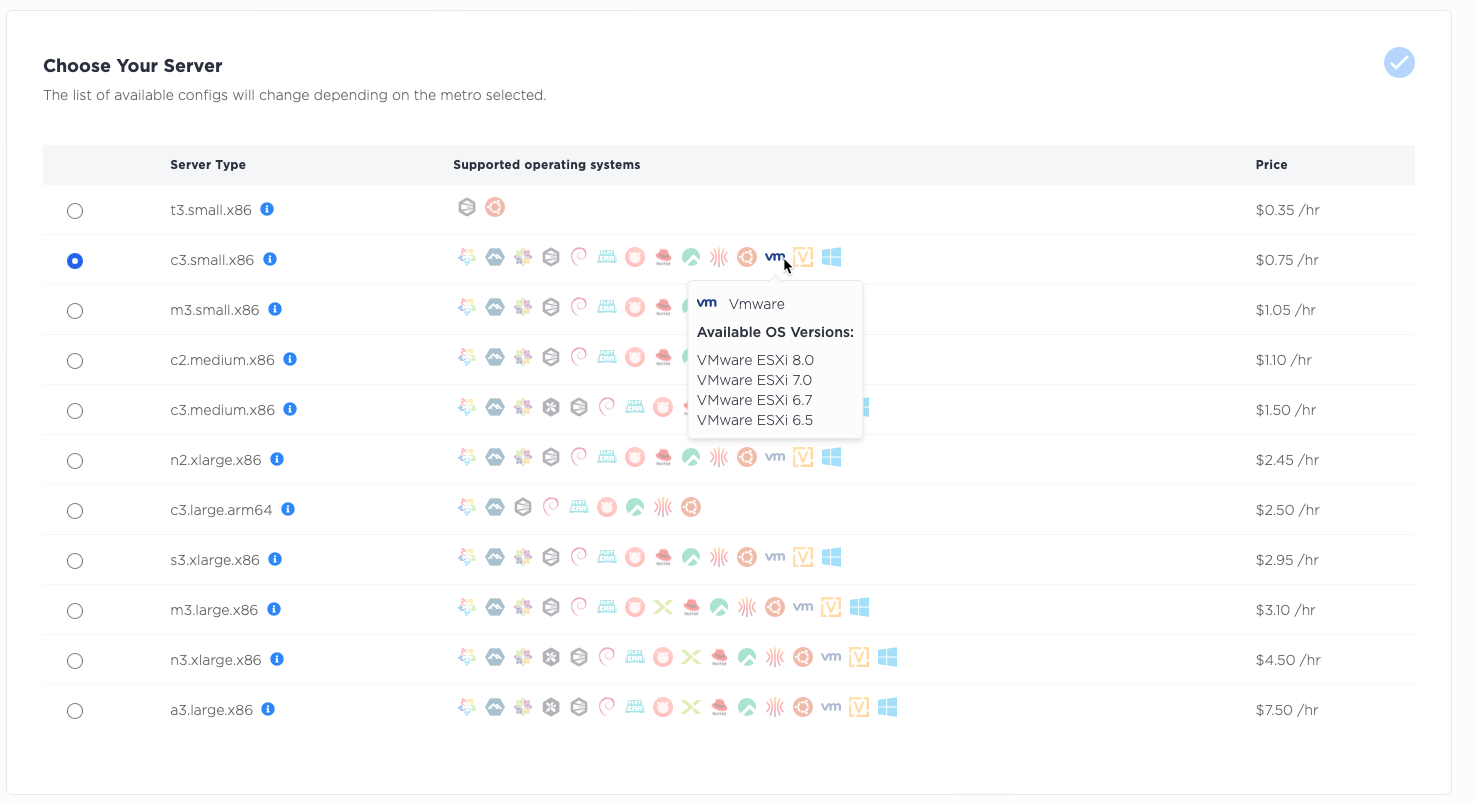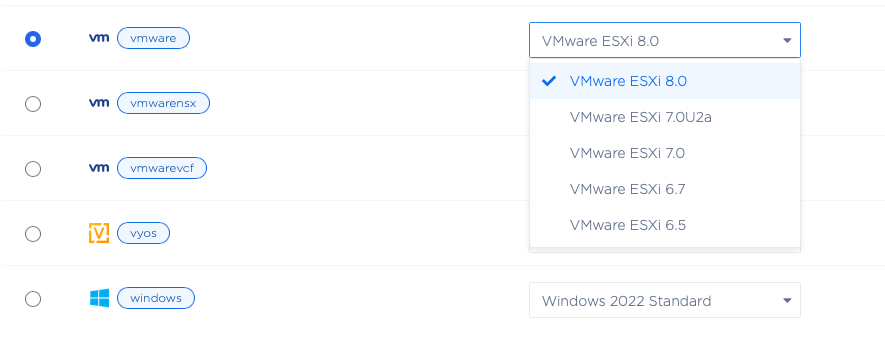- Home /
- Resources /
- Learning center /
- Breakdown of On-De...
Breakdown of On-Demand Equinix Metal Servers for VMware Workloads
Analyzing which on-demand servers are suitable for VMware workloads

One of the best part of Equinix Metal is having many server types at your fingertips, all avaible within minutes. There is a server that will do exactly what you need it to just waiting for you. Because there are so many choices available, it is important to keep in mind the workloads you will be running on Metal servers. When it comes to VMware workloads there are a few things to think about, such as:
- Metro
- Server hardware
- VMware version
Let’s take a closer look at each of these as you pick your on-demand server for VMware.
First things first, it is a good idea to get a feel for the server types available on-demand at Equinix Metal:

We’re going to dive deeper into each of these servers, their specifications, and what VMware use cases they align to, but there are few things to think about before we do that.
A major consideration is the Metro you will deploy in. Not every server is available in every Metro. To take a look at what is currently available, be sure to take a look at the Equinix Metal Capacity Dashboard. This dashboard will let you sort by availability, server type, and Metro.
It’s a good idea to take a quick look at your target Metro or Metros to get an idea of what hardware is available, as this can be a design constraint. After you have an idea of where you are going to deploy, now you can take a closer look at the specs of the available hardware, which we are about to dive into.
The good news is that Gen3 servers support VMware workloads, it is easy to see what operating systems are available on each server from the Metal deployment console.

You can also take a look at the Equinix Metal OS Compatibility page, and select your ESXi version there.
Now let’s take a closer look at the specs for the current sever generation, and what you should consider when running VMware.
Analyzing on-demand servers
a3.large.x86
This server has a great deal of both processor and memory, along with 4 x 25 Gbps network interfaces. If you are designing an environment with performance in mind, this is an excellent choice. It is important to note that there is no internal storage available on this server beyond boot devices.
c3.medium.x86
This server is great candidate for test environments, especially when testing deployment automation since it is lower on resources and network ports with 2 x 10 Gbps. It does have 2 x 480 GB SSDs which can be used for deployment of test VMs
m3.large.x86
This server is a great candidate for virtualization with 32 cores and 256 GB of RAM, and 2 x 25 Gbps network cards. It also has 2 x 3.8 TB NVMe devices. If you’re looking for a test sever, this can be a good candidate by using the internal storage for testing, before deploying external storage for a full scale production environment.
m3.small.x86
This server does not have internal storage, or a great deal of memory at 64 GB. If you are looking to use VMware as hardware failure abstraction layer for a workload with a lower resource utilization, this server can be a great choice.
n3.large.x86
This server has 4 x 25 Gbps network ports, and is network focused. It also has 32 cores and 512 GB of RAM, as well as 2 x 3.8 TB NVMe devices. This is a great candidate for storage intensive workloads, as with the number of network ports, you can have dedicated IP storage NICs for external storage.
s3.xlarge.x86
This can be good for test workloads or workloads that are not high performance or don’t high resource requirements. With 24 cores, 192 GB of RAM, 2 x 10 Gbps NICs and 12 x 8 TB HDD. Keep in mind the HDD storage will not have the best performance for virtual machines, but that can be changed by using external storage. For production workloads, external storage is highly recommended.
Remember, If you need to check what version of VMware ESXi is supported on a server mid deployment, you can see this information in the On Demand Server Deployment screen. Simply hover your mouse over the VMware logo to see the versions supported on the sever, or once you select the server model, you can look at the options in the drop down menu in the Choose Your Operating System Pane

As you can see, it is simple to have a modern ESXi server up and running in a few minutes with Equinix Metal. It is also easy if you need to deploy an earlier version of ESXi in case you want to perform testing, like upgrade or patch testing.
With Equinix Metal, it is simple to request additional hardware. As your requirements change and grow, you can simply deploy additional servers to meet your needs. If you find out a server isn’t quite right for the workloads you need to run, you can simply deploy a different server type, and migrate your workloads over, without the hassle of having to order, rack, and stack new hardware, or explain to management the wrong servers were selected.
Recap – Up and Running with VMware ESXi on Equinix Metal
Now that we have covered the basics, let’s recap how simple it is to be up and running with an ESXi host in a few minutes:
-
Choose your Metro: Simply select which Metro you plan on deploying in. You can look at the map here.
-
Choose your server: Now that you have a good understanding of what options are available on-demand on Equinix Metal, choose the server model that works for you. Change your mind later? No problem now that you know how simple it is to deploy a new ESXi host. Be sure to look at the Capacity dashboard to see what is available in your chosen Metro.
-
Choose your VMware version: Once you know your Metro and server version, you can log into the Equinix Metal console, and choose the version of ESXi you plan on deploying.
Equinix Metal's on-demand servers offer a versatile and powerful platform for VMware ESXi deployments, catering to just about every need and scenario imaginable. The key to harnessing this power lies in carefully selecting your Metro, server hardware, and VMware version.
With a range of server types each suited to specific use cases, from high-performance environments to test and training setups, Equinix Metal ensures flexibility and scalability. This ease of deployment, combined with the ability to quickly adapt to changing requirements and straightforward server management, makes Equinix Metal an excellent choice for running VMware ESXi and VMware vSphere.
Whether you're a seasoned VMware administrator or new to the platform, the integration of VMware with Equinix Metal simplifies the process, allowing for efficient, effective, and adaptable virtualization solutions.
You may also like
Digger deeper into similar topics in our archives
Configuring BGP with BIRD 1.6 on an Equinix Metal Server
Set up BGP on your Equinix Metal server using BIRD 1.6, covering IP configuration, installation, and neighbor setup to ensure robust routing capabilities between your server and the Equinix Metal network.

Configuring BGP with FRR on an Equinix Metal Server
Establish a robust BGP configuration on your Equinix Metal server using FRR, including setting up network interfaces, installing and configuring FRR software, and ensuring secure and efficient IP address announcement.

Crosscloud VPN with Wireguard
Learn to establish secure VPN connections across cloud environments using WireGuard, including detailed setups for site-to-site tunnels and VPN gateways with NAT on Equinix Metal, enhancing cross-platform security and connectivity.

Deploy Your First Server
Learn the essentials of deploying your first server with Equinix Metal. Set up your project & SSH keys, provision a server and connect it to the internet.

Ready to kick the tires?
Use code DEPLOYNOW for $250 credit